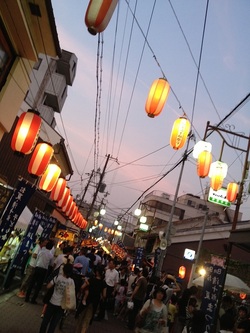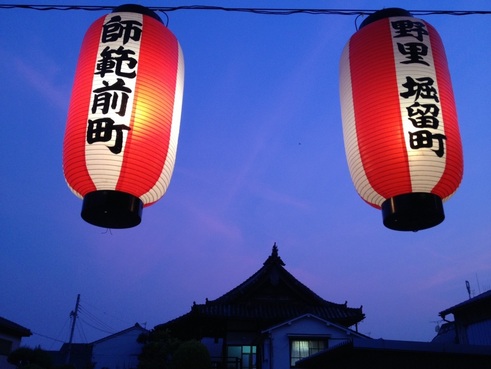 Festival fever beats cabin fever Festival fever beats cabin fever Beebedy-beep-beep. Tonight’s air traffic over Japan will be heavier than usual. Across the archipelago, over city, town and paddy, spirits of all ancestors will return en masse to the spirit world. Obon has been a blast (for them). Three days of lurking and lingering in incense-filled rooms, with the pinging and bonging of altar chimes and the hum and drone of the visiting Buddhist priest’s sutras to venerate their retired souls. In addition, the living must leave their cool, dark homes and venture out under a blistering August sun to pay further homage. This means, for my old friend Ono-san and my old kitchen gardener mate Smokin’ Joe Matsumoto, a trip to the cemetery. City of the Dead, Spirit Suburbia, Hallowed Heights--call it what you will, but here in Himeji city, Ono-san, Matsumoto-san and half a million more, know it as Nagoyama: an entire hillside combed by long, neat rows of gravestones which rise to a Buddhist stupa at the summit. From here I would like to say that ‘on a clear day you can see forever’ but the mills of Nippon Steel on coast cause me to swallow my words. Small paper lanterns are lit and placed at the graves on the first day of Obon to ‘guide’ the spirits in--much like the runway lights of Kansai International Airport. Gravestones are then wetted and cooled with ladles of water and rubbed off, their chrysanthemums changed, offerings made, candles lighted, incense burned and prayers murmured. Occasionally a hard-up drifter might take liberties with the offerings of fruit, snacks and cans of beer and sake, there’s no law against it, but you won’t catch me peeling hot oranges and drinking boiling beer. Obon is a strangely eerie time. Cicadas fall out of the sky dead, crisp as beer snacks, the streets and alleys of the Good Hood, my home for 14 years, are suddenly lifeless, dreary even. Thankfully, Obon is sandwiched by vibrant summer festivals--in the weeks before and after, fireworks turn the nights into day and Himeji’s neighborhood streets fill with stalls and parades of dancing women in yukatas. And the Good Hood, despite its slow decline, partakes. Woo-hooo! Lanterns are hoisted high on the shopping street, yakitori and cotton candy stalls materialise and the courtyard of Keiunji Buddhist temple glows with candles and the cheeks of old shakuhachi flute players who have drunken too much beer. Children appear in yukata, followed by parents and hobbling parents’ parents, all eager to sample the night’s delights; for the kids, that’s mountains of coloured ice and for parents, an icy beer will do nicely. Obon also means the return to hometowns of old school friends, which in turn means you will be hard-pressed to get a table at any of the city’s rooftop beer gardens around this time because of all the sodden reunioning. Seaside Japan empties too after Obon; kids suddenly remember the mountains of summer holiday homework they haven’t touched, while company workers trudge drearily off to catch a bus to somewhere they’d rather forget, dreaming instead of the past week’s seafood feasts, bikini girls and white caps of the Japan Sea or Pacific Ocean. And just like that, summer is gone, slipped through our fingers. Melted away like a wily spirit. Next week: Where can you get a good cup of coffee in a land famous for tea? Why, the Good Hood of course!
0 Comments
Leave a Reply. |
This Blog:What is the essence of a traditional Japanese neighbourhood? Writing from my home in Himeji, a castle town in western Honshu, Seaweed Salad Days distills, ferments, presents! Archives
March 2024
Categories
All
|

 RSS Feed
RSS Feed
